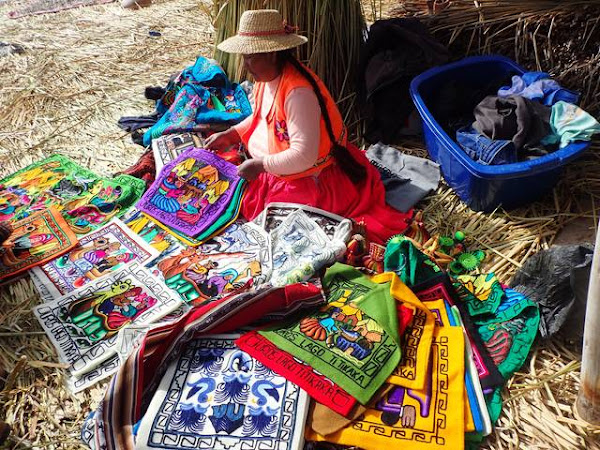Lake Titicaca
Lake Titicaca, conjures up thoughts of a timeless tribe of people living on a flotilla of reed islands in a huge elevated fresh water lake. Though now somewhat contrived, they are valid thoughts. Lake Titicaca is huge at around 190km long and 80km wide in places. It shares a border with Peru and Bolivia. We stayed on the Peruvian side, arriving at Puno.

We started our day hiring a kayak to explore the paths created my the
water between the reeds. This was a good way to get the blood flowing
after a long day of travel from Cuzco yesterday.

The Uros people built islands out reeds as a security measure to keep safe from attacking tribes for example the Incas and their boats for fishing and transport. Today, many have elected not to continue with this lifestyle, but a few
have remained. For tourism and nostalgic attachment to the traditional,
less stressed life that is offered as against that in modern cities.

There are some animals that are farmed eg chickens and ibis and fish is a main constituent of their diet. As well, parts of the totora reed can be eaten.

The tourist vessels are painted in bright colours and are fun way to visit the islands.

The houses are quite primitive,but there are some modern trappings afforded by solar panels eg. mobile phones and television. The surface is quite spongy to walk on being made of reed. There is sanitation to remove waste, which I hope is not simply dumped in the lake. The huts look warm enough, I wonder if there are issues with damp ....

For us as tourists we are treated with displays of traditional garb and cultural explanation.

We visited and stayed overnight at Amanataní island, which is inhabited by the Aymara people.

'The decor was quite gaudy, but why not be bright and cheerful ?

We were greeted by some people dressed in cultural garb. We had a talk on meaning of the dress and cultural aspects of their tribe.

The island is quite dry, but nature still has its way providing beautiful blooms to decorate the gardens and open land.


There are well managed paths to explore. Outside of the greeting by our tourism hosts, it is evident that the locals do enjoy sticking to the traditional garb, for example with their hats.

Archways, like many civilisations are a gateway to the community, or of religious significance.

Like most islands, sunsets and sun rise are a thing of beauty, especially up here at the high elevation of 3800m

Being an old civilisation, who knows, the sun shining through at certain times could be of great significance on this arch or maybe just a means to get from one side to the other.

For this trip we were invited to the local dance. We got to dress up in the traditional costumes.

The dance was good fun, but the hall was quite stifling, so we had to leave early. It could also be the altitude. Even though we were well acclimatized, it was still not that easy to move energetically.

Handicrafts, such as weving are very much a means of income as well as important for furnishings and clothing.

Resistance is futile. I bought some souveniers, they are are useful for gifts at home.

I felt that we got our moneys worth on this trip, in consideration of the nice accommodation, boat trip, presentations, entertainment. In places at home you could pay that just for a sumptuous lunch.

It gets quite windy on the lake at times, so the boats are protected by these safe harbours scattered around the island.

This time we boarded a modern vessel to get to the island. Pressures of modern times I guess, we don't have the luxury of dawdling to get there and back.

I am glad we visited Lake Titicaca, and the civilisations on the islands. It was worth the effort, and a fitting conclusion to our trip to Peru.

Comments
Post a Comment